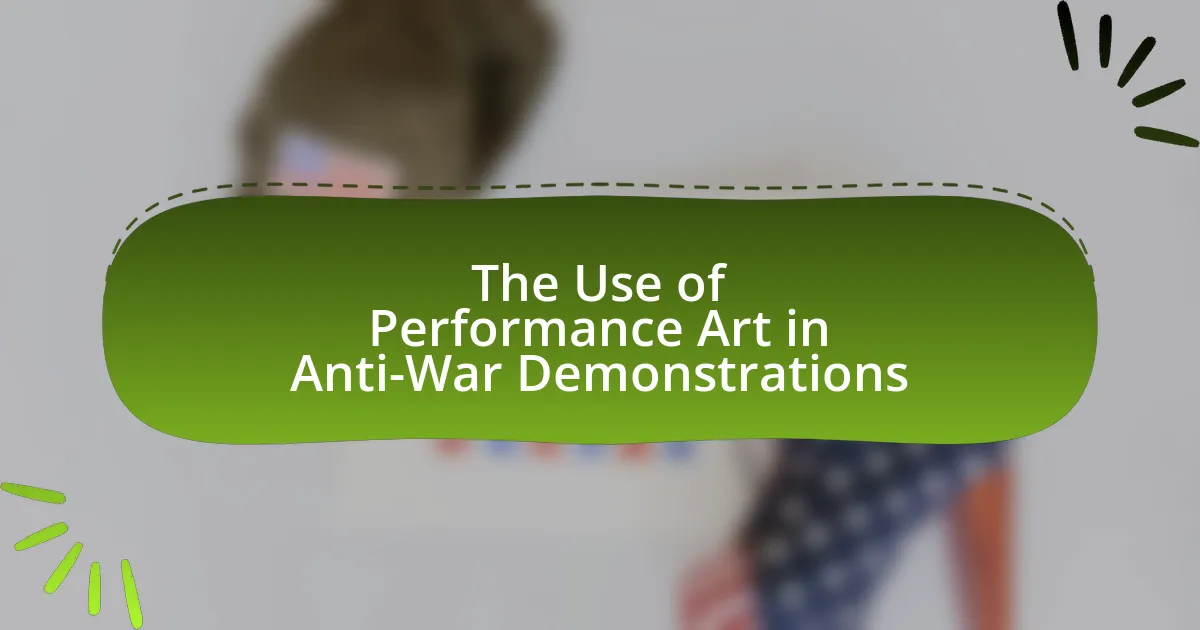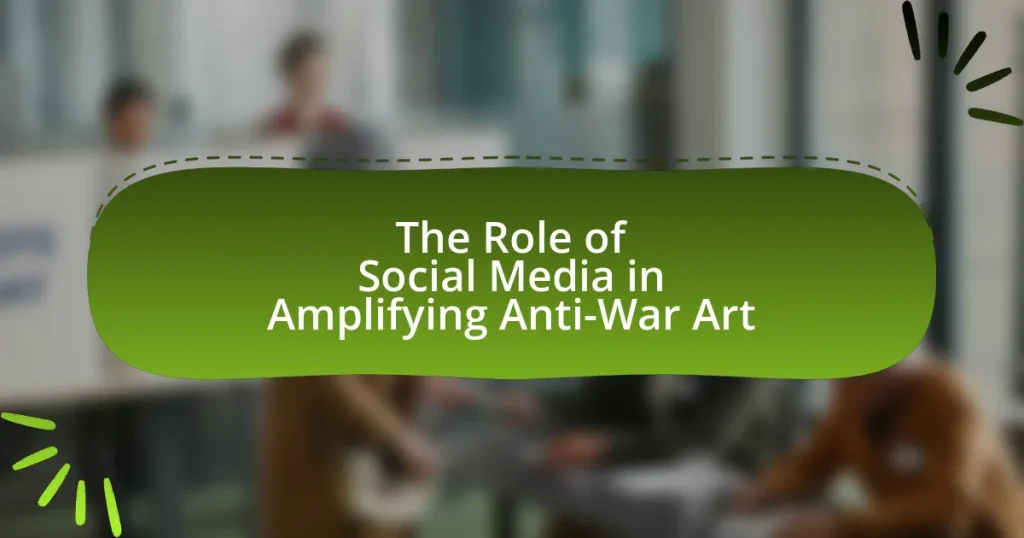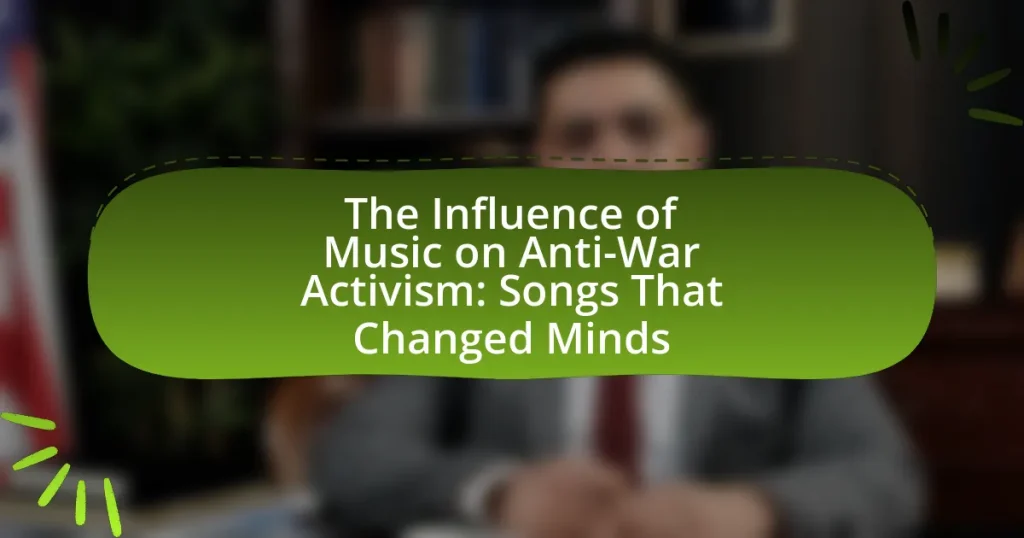Performance art serves as a vital medium in anti-war demonstrations, facilitating emotional expression and social critique through visceral engagement. This article explores the historical use of performance art in protests against war, highlighting notable examples and the emotional responses they evoke in audiences. It examines the effectiveness of various forms of performance art, such as street theater and live installations, in conveying anti-war messages, as well as the challenges artists face, including censorship and public reception. Additionally, the article discusses strategies artists employ to enhance their impact and adapt to societal reactions, ultimately illustrating the significant role performance art plays in shaping public perception and fostering dialogue around war and peace.

What is the role of performance art in anti-war demonstrations?
Performance art plays a crucial role in anti-war demonstrations by serving as a powerful medium for emotional expression and social critique. This form of art engages audiences on a visceral level, often using symbolism and direct action to convey the horrors of war and the impact on human lives. For instance, performances may include reenactments of war scenes or the use of visual metaphors that highlight the suffering caused by conflict, thereby fostering empathy and raising awareness among participants and observers. Historical examples, such as the “Theatre of the Oppressed” initiated by Augusto Boal, illustrate how performance art can mobilize communities and provoke dialogue about war and peace. Through these artistic expressions, anti-war movements can effectively communicate their messages, challenge dominant narratives, and inspire collective action against militarism.
How has performance art been historically used in protests against war?
Performance art has historically been used in protests against war as a powerful medium to convey dissent and evoke emotional responses. For instance, during the Vietnam War, artists like Judith Malina and the Living Theatre utilized immersive performances to challenge militarism and highlight the human cost of conflict. Additionally, the 1980s anti-nuclear movement saw artists like Karen Finley use provocative performances to critique government policies and raise awareness about the dangers of nuclear warfare. These performances often engaged audiences directly, creating a visceral connection to the issues at hand, thereby amplifying the anti-war message and fostering a sense of community among protesters.
What are some notable examples of performance art in anti-war movements?
Notable examples of performance art in anti-war movements include “The Vietnam Veterans Memorial” by Maya Lin, which serves as a poignant reminder of the human cost of war, and “Theatre of the Oppressed” by Augusto Boal, which engages communities in dialogue about war and oppression. Additionally, the “Guerilla Girls” have used provocative performances to critique military actions and promote peace. These works exemplify how performance art can effectively convey anti-war messages and foster public discourse on the consequences of conflict.
How do these examples illustrate the impact of performance art on public perception?
Performance art significantly influences public perception by transforming abstract anti-war messages into visceral experiences. For instance, the use of dramatic visual elements and emotional narratives in performances can evoke empathy and provoke critical thought among audiences, making them more receptive to anti-war sentiments. Historical examples, such as the “Vietnam Veterans Against the War” performances in the 1970s, effectively highlighted the human cost of conflict, leading to increased public awareness and opposition to the Vietnam War. This illustrates how performance art can serve as a catalyst for social change by reshaping collective attitudes and encouraging dialogue around contentious issues.
Why is performance art an effective medium for anti-war messages?
Performance art is an effective medium for anti-war messages because it engages audiences emotionally and physically, creating a visceral response that traditional forms of communication often lack. This art form allows for direct interaction and participation, making the message more impactful and memorable. For instance, works like Marina Abramović’s “The Artist is Present” demonstrate how the presence and vulnerability of the performer can evoke deep empathy and reflection on the human cost of war. Additionally, performance art often incorporates elements of shock and surprise, which can challenge viewers’ perceptions and provoke critical thought about the consequences of conflict. Historical examples, such as the “Vietnam Veterans Against the War” performances in the 1970s, illustrate how this medium can effectively convey the trauma and moral dilemmas associated with war, thereby fostering a powerful anti-war sentiment.
What emotional responses does performance art evoke in audiences?
Performance art evokes a range of emotional responses in audiences, including empathy, anger, and introspection. These emotional reactions are often intensified by the visceral nature of performance art, which can confront viewers with stark realities and provoke deep reflection on social and political issues. For instance, studies have shown that performance art can create a sense of urgency and connection to the themes being presented, particularly in the context of anti-war demonstrations, where artists use their bodies and narratives to challenge prevailing narratives and evoke a strong emotional response. This engagement can lead to increased awareness and motivation for social change, as evidenced by the impact of notable performances during historical protests, which have been documented to shift public sentiment and inspire collective action.
How does performance art differ from traditional protest methods?
Performance art differs from traditional protest methods primarily in its emphasis on experiential engagement and emotional expression rather than solely on verbal or written communication. Traditional protest methods, such as marches or speeches, often rely on slogans and direct messages to convey dissent, while performance art utilizes the body, movement, and visual elements to evoke feelings and provoke thought, creating a more immersive experience for the audience. For instance, the anti-war performance piece “The Artist is Present” by Marina Abramović engaged viewers in a silent dialogue about conflict and presence, contrasting with the more straightforward messaging of a protest rally. This approach can lead to deeper reflections on the issues at hand, making performance art a unique and impactful form of protest.
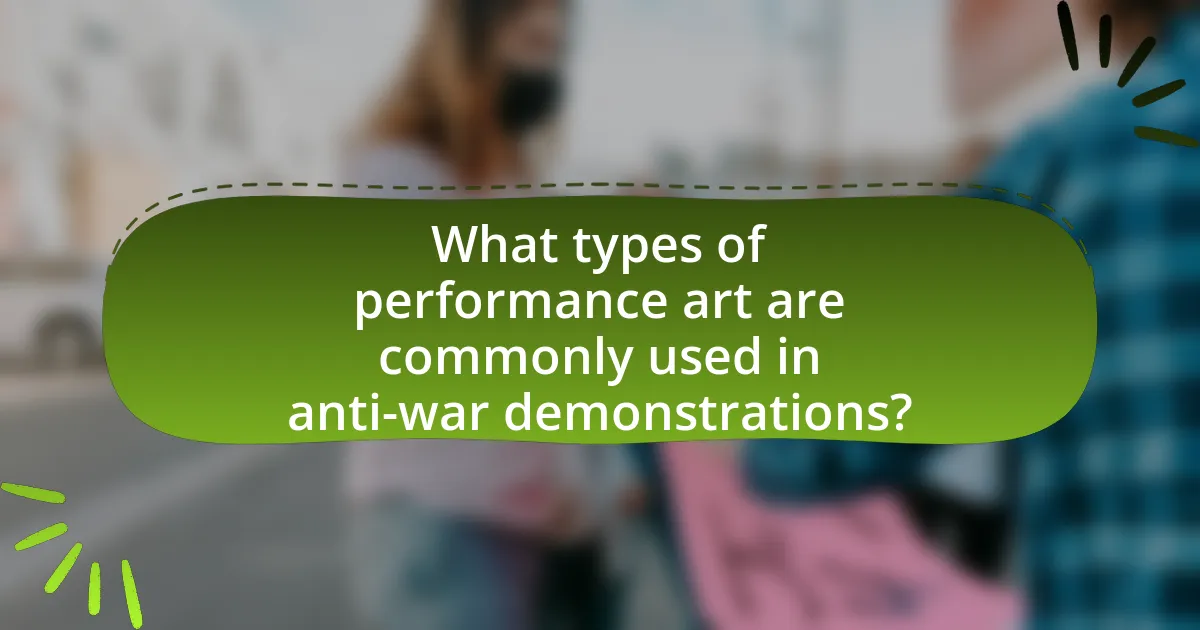
What types of performance art are commonly used in anti-war demonstrations?
Common types of performance art used in anti-war demonstrations include street theater, live art installations, and protest music. Street theater often involves dramatizations that highlight the consequences of war, engaging audiences through relatable narratives. Live art installations can create immersive experiences that provoke thought and discussion about the impacts of conflict. Protest music, performed in public spaces, serves to unify participants and convey powerful messages against war. These forms of performance art have historically been effective in raising awareness and mobilizing communities, as seen in events like the Vietnam War protests where theatrical performances and music played crucial roles in conveying anti-war sentiments.
What are the various forms of performance art utilized in these protests?
Various forms of performance art utilized in anti-war protests include street theater, live art installations, and symbolic acts such as die-ins. Street theater often involves dramatizations that convey anti-war messages, engaging audiences in a narrative that critiques military actions. Live art installations can create immersive experiences that provoke thought and discussion about the consequences of war. Symbolic acts, like die-ins, visually represent the loss of life due to conflict, making a powerful statement about the human cost of war. These forms of performance art effectively communicate dissent and mobilize public sentiment against military actions.
How do street theater and live art contribute to anti-war messages?
Street theater and live art effectively contribute to anti-war messages by engaging audiences emotionally and provoking critical thought about the consequences of war. These forms of performance art often utilize satire, symbolism, and direct interaction with the public to challenge prevailing narratives and highlight the human cost of conflict. For instance, the “Theater of the Oppressed” movement, founded by Augusto Boal, emphasizes participatory techniques that empower audiences to envision alternatives to violence and oppression. Additionally, events like the “Puppet Show for Peace” during the Iraq War showcased how visual storytelling can convey powerful anti-war sentiments, making complex issues accessible and relatable. Such performances not only raise awareness but also foster community dialogue, reinforcing the collective opposition to war.
What role does multimedia play in enhancing performance art for anti-war purposes?
Multimedia significantly enhances performance art for anti-war purposes by integrating various forms of expression, such as video, sound, and digital imagery, to create a more immersive and impactful experience. This integration allows artists to convey complex emotions and narratives that resonate with audiences on multiple sensory levels, thereby increasing engagement and awareness of anti-war messages. For instance, the use of projected images of war-torn landscapes alongside live performances can evoke strong emotional responses, making the anti-war message more poignant and memorable. Research indicates that performances incorporating multimedia elements can lead to greater audience retention of the themes presented, as seen in works like “Theater of War,” which combines live readings with multimedia to address the consequences of conflict.
How do artists choose the themes and messages for their performances?
Artists choose the themes and messages for their performances by reflecting on personal experiences, societal issues, and historical contexts. This process often involves a deep engagement with the political climate, cultural narratives, and emotional responses to conflict, particularly in the context of anti-war demonstrations. For instance, artists may draw inspiration from events such as the Vietnam War protests, where performance art became a medium for expressing dissent and raising awareness about the consequences of war. Research indicates that performance art can effectively communicate complex themes, as seen in works by artists like Marina Abramović, who often explores themes of endurance and vulnerability in relation to societal issues. This alignment of personal and collective narratives helps artists craft performances that resonate with audiences and provoke critical thought about war and peace.
What factors influence the selection of specific anti-war themes in performance art?
The selection of specific anti-war themes in performance art is influenced by cultural context, historical events, and the intended audience. Cultural context shapes the themes by reflecting societal values and beliefs, while historical events provide a backdrop that artists respond to, such as wars or conflicts that have impacted communities. The intended audience also plays a crucial role, as artists may choose themes that resonate with the experiences or emotions of their viewers, aiming to provoke thought or inspire action. For instance, the Vietnam War era saw performance art that critiqued military actions, reflecting public sentiment and historical realities.
How do cultural and social contexts shape the messages conveyed through performance art?
Cultural and social contexts significantly shape the messages conveyed through performance art by influencing the themes, symbols, and narratives that artists choose to express. For instance, performance art often reflects societal issues, such as war, by utilizing culturally relevant symbols and language that resonate with the audience’s experiences and beliefs. Historical examples include the anti-war performances during the Vietnam War era, where artists like Judith Malina and the Living Theatre used their work to critique militarism and promote peace, effectively engaging audiences through shared cultural references and social critiques. This alignment with cultural and social contexts enhances the emotional impact and relevance of the performance, making the messages more poignant and accessible to the audience.
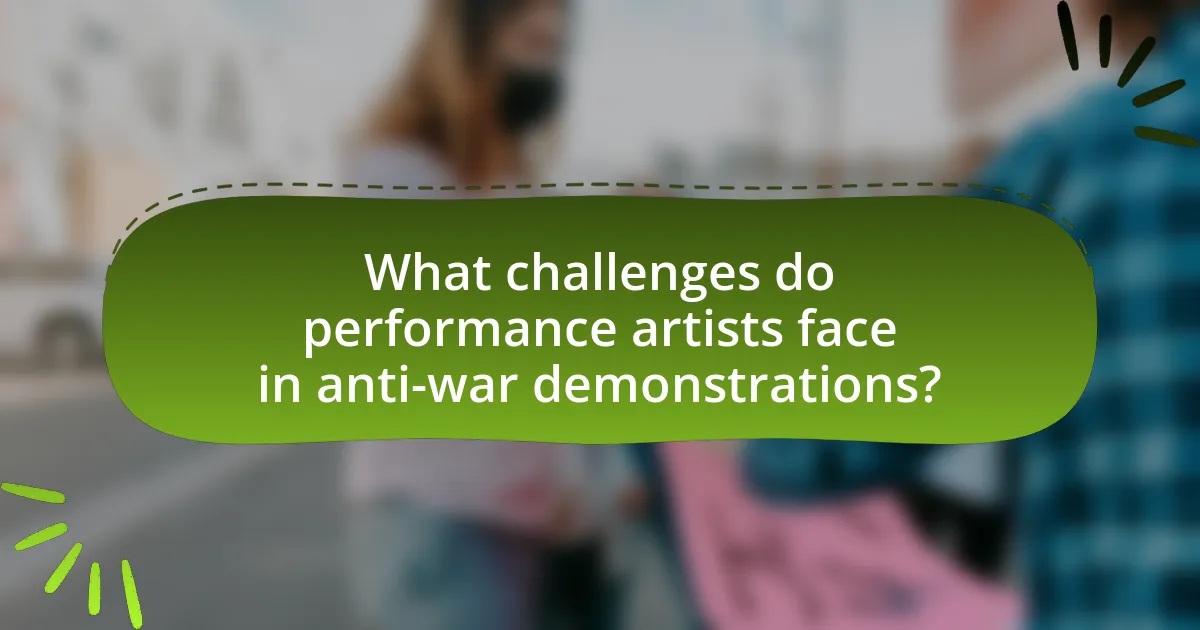
What challenges do performance artists face in anti-war demonstrations?
Performance artists face several challenges in anti-war demonstrations, including censorship, public reception, and legal restrictions. Censorship can occur when authorities or organizations attempt to limit or control the content of performances that critique war, as seen in various instances where performances were shut down or altered to avoid controversy. Public reception poses another challenge, as audiences may have differing views on war, leading to polarized reactions that can affect the artists’ message and impact. Legal restrictions, such as permits and regulations governing public gatherings, can hinder performance artists’ ability to express their anti-war sentiments freely. These challenges highlight the complex environment in which performance artists operate during anti-war demonstrations.
What are the legal and logistical obstacles for performance artists in protests?
Performance artists in protests face significant legal and logistical obstacles, including restrictions on public assembly and permits required for performances. Legal challenges arise from laws that regulate noise levels, public safety, and the use of public spaces, which can limit the scope and impact of artistic expression. Logistically, performance artists must navigate the complexities of coordinating with local authorities for permits, securing locations, and managing crowd control, all of which can hinder their ability to effectively convey their message. For instance, in many jurisdictions, failure to obtain the necessary permits can lead to arrests or fines, as seen in various protests where artists were detained for performing without authorization.
How do restrictions on public gatherings affect performance art in anti-war demonstrations?
Restrictions on public gatherings significantly limit the scope and impact of performance art in anti-war demonstrations. These limitations often lead to reduced audience sizes, hindering the ability of artists to convey their messages effectively. For instance, during the COVID-19 pandemic, many countries imposed strict gathering limits, which forced artists to adapt their performances to smaller, more private settings or to virtual platforms, thereby diminishing the communal experience that is vital for impactful anti-war expressions. Additionally, legal repercussions for violating gathering restrictions can deter artists from participating in public demonstrations, further stifling creative expression and the potential for collective activism.
What strategies do artists use to overcome these challenges?
Artists use various strategies to overcome challenges in anti-war demonstrations through performance art. These strategies include collaboration with other artists and activists to amplify their message, utilizing social media platforms for wider reach and engagement, and incorporating interactive elements in their performances to foster audience participation. For instance, the performance piece “The People’s Choice” by artist Tania Bruguera involved audience members in decision-making processes, effectively engaging them in the political discourse surrounding war. Additionally, artists often adapt their work to address current events, ensuring relevance and resonance with the audience, as seen in the works of groups like the Guerrilla Girls, who use humor and satire to critique war and violence. These approaches not only enhance the impact of their art but also create a sense of community and shared purpose among participants and viewers.
How do societal reactions impact the effectiveness of performance art in anti-war movements?
Societal reactions significantly influence the effectiveness of performance art in anti-war movements by shaping public perception and engagement. When audiences respond positively, performance art can amplify anti-war messages, fostering empathy and encouraging activism. For instance, the 2003 “Stop the War” protests in the UK featured performance art that resonated with the public, leading to widespread media coverage and increased participation. Conversely, negative societal reactions can diminish the impact of such art, as seen when controversial performances provoke backlash, leading to censorship or disengagement. Thus, the interplay between societal reactions and performance art is crucial in determining the success of anti-war initiatives.
What backlash or support do performance artists encounter during anti-war demonstrations?
Performance artists often encounter both backlash and support during anti-war demonstrations. Backlash can manifest as criticism from individuals or groups who disagree with the political message or the methods of expression used, sometimes leading to confrontations or attempts to censor the performance. For instance, during the 2003 Iraq War protests, some performance artists faced hostility from pro-war factions who viewed their art as disrespectful or inflammatory. Conversely, support for performance artists frequently comes from like-minded activists and audiences who appreciate the emotional and provocative nature of their work, recognizing it as a powerful tool for raising awareness and fostering dialogue about war-related issues. This duality of response highlights the contentious nature of political art in public spaces, where the impact of performance can elicit strong reactions on both sides of the political spectrum.
How can artists adapt their performances in response to public reception?
Artists can adapt their performances in response to public reception by modifying content, style, and delivery based on audience feedback. For instance, if an anti-war performance receives a positive reaction to a specific theme, artists may choose to emphasize that theme in future presentations. Conversely, if certain elements provoke negative reactions, artists can alter or remove those aspects to better align with audience sentiments. Historical examples include the Vietnam War protests, where artists like Joan Baez adjusted their music to reflect the evolving public opinion on war, demonstrating the effectiveness of responsiveness in performance art.
What best practices can performance artists follow to enhance their impact in anti-war demonstrations?
Performance artists can enhance their impact in anti-war demonstrations by creating emotionally resonant and thought-provoking performances that engage the audience. Engaging storytelling, visual symbolism, and interactive elements can evoke strong emotional responses, making the message more memorable. For instance, the use of historical references, such as reenacting significant anti-war events, can provide context and deepen the audience’s understanding of the issues at hand. Additionally, collaborating with local communities and activists can amplify the message and ensure it resonates with diverse audiences. Research indicates that performances that incorporate audience participation can lead to increased awareness and advocacy, as seen in the work of artists like Marina Abramović, who effectively used her platform to address social issues.
